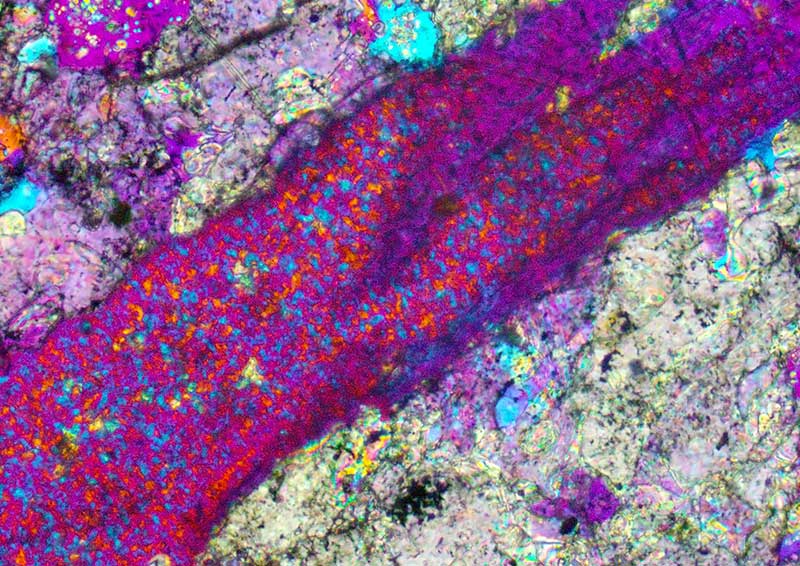Alkali-aggregate reaction (AAR)
(Microscopic view of crystalline AAR product in cracked aggregate from a concrete bridge (Leemann et al, 2016).)
[edit] Introduction
The dominance of Portland cement concrete as the world's pre-eminent structural material developed during the 19th century and continued throughout the 20th century and retains that position today.
However, the material had a 'guilty secret' that was only revealed by research in the USA during the 1930s. In some circumstances, an expansive reaction can gradually occur between aggregate constituents and alkaline hydroxides from the cement, causing damage to the hardened concrete within structures.
This has become known as 'alkali-aggregate reaction' (AAR), or most commonly and more specifically, 'alkali-silica reaction' (ASR). This AAR family of mechanisms is by no means the most frequently encountered threat to concrete durability or the serviceability of structures, but it can be a serious issue when it occurs.
It has continued to fascinate concrete research scientists and engineers ever since its first published description, some 76 years ago.
[edit] Getting to grips with AAR
Over more than 40 years, I have been privileged to witness practising engineers and applied scientists getting to grips with AAR worldwide. I believe we now understand the several reactions, including how to recognise them in existing structures and manage the situation, but crucially also including how to determine any possible AAR potential in new works and take effective precautionary measures.
However, challenges remain, especially as appreciation of the potential threat from AAR is not universally or equally appreciated everywhere in the world, and we are still finding types of structure that behave exceptionally. Overall, the prospects are encouraging for both a declining incidence of AAR damage and successful approaches to management and/or repair of affected cases.
This article was originally published by ICE on 30 June 2016. It was written by Simon Fullalove. You can see the original article here.
--The Institution of Civil Engineers
[edit] Related articles on Designing Buildings Wiki
Featured articles and news
OpenUSD possibilities: Look before you leap
Being ready for the OpenUSD solutions set to transform architecture and design.
Global Asbestos Awareness Week 2025
Highlighting the continuing threat to trades persons.
Retrofit of Buildings, a CIOB Technical Publication
Now available in Arabic and Chinese aswell as English.
The context, schemes, standards, roles and relevance of the Building Safety Act.
Retrofit 25 – What's Stopping Us?
Exhibition Opens at The Building Centre.
Types of work to existing buildings
A simple circular economy wiki breakdown with further links.
A threat to the creativity that makes London special.
How can digital twins boost profitability within construction?
The smart construction dashboard, as-built data and site changes forming an accurate digital twin.
Unlocking surplus public defence land and more to speed up the delivery of housing.
The Planning and Infrastructure Bill
An outline of the bill with a mix of reactions on potential impacts from IHBC, CIEEM, CIC, ACE and EIC.
Farnborough College Unveils its Half-house for Sustainable Construction Training.
Spring Statement 2025 with reactions from industry
Confirming previously announced funding, and welfare changes amid adjusted growth forecast.
Scottish Government responds to Grenfell report
As fund for unsafe cladding assessments is launched.
CLC and BSR process map for HRB approvals
One of the initial outputs of their weekly BSR meetings.
Building Safety Levy technical consultation response
Details of the planned levy now due in 2026.
Great British Energy install solar on school and NHS sites
200 schools and 200 NHS sites to get solar systems, as first project of the newly formed government initiative.
600 million for 60,000 more skilled construction workers
Announced by Treasury ahead of the Spring Statement.

























